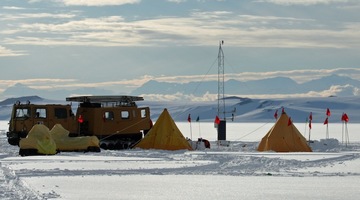Dr Adrian McDonald tells us about some of the satellites he uses to measure temperature and the chemical composition of the Earth’s atmosphere
Jargon alert:
A satellite constellation is a group of satellites with coordinated ground coverage. They are synchronised and operate under shared control.
Transcript
DR ADRIAN MCDONALD
So the areas of research that I’m interested in are Antarctic climate and stratospheric ozone depletion, so the Antarctic ozone hole. I use a number of satellites, and some of those satellites measure the chemical composition, so they tell me how much ozone there is at a certain altitude above the Earth’s surface. So it might be ozone or it might be bromine or those chlorine species that break up ozone.
I also use satellites that measure temperature, and those satellites are important because most chemical reactions are temperature dependent so you need to understand temperature to be able to understand what’s going to happen chemically to ozone.
So there’s many different satellites that measure chemical composition. Most of them examine electromagnetic radiation, so visible light or infrared or ultraviolet light, and by measuring at different wavelengths, they can say something about the composition of the species.
The Earth Observing System Microwave Limb Sounder – it’s basically one instrument on a satellite, and that satellite measures both chemical composition and temperature by examining emissions of light of certain frequencies from the atmosphere
This particular polar orbiting satellite orbits the Earth about 20 times a day, and in each path as the Earth’s rotating round, it’s measuring a different path as it’s rotating around the Earth. And by doing that it can make about 3000 measurements over the Earth in a day.
The satellite that I use mostly to measure temperature is something called COSMIC FORMOSAT-3 – it’s a constellation of satellites.
Temperature is very hard to measure above a certain level, so standard weather balloons worked up until about 25 kilometres, and generally the balloon pops about that time and therefore they can’t make any measurements above that. COSMIC FORMOSAT-3 measures from about 7 or 8 kilometres to about 50 kilometres so it’s a much wider range of temperatures in the atmosphere, and also it’s more representative again because satellites can get coverage globally and a significant number of measurements over Antarctica. And without satellite observations, you just won’t get that because there’s only five or six manned stations over Antarctica where they actually launch weather balloons to measure the atmosphere’s temperature.
Acknowledgements:
NASA Ozone Watch/Goddard Space Flight Center
Scientific Visualization Studio
NASA/JPL
NIWA, Lauder



